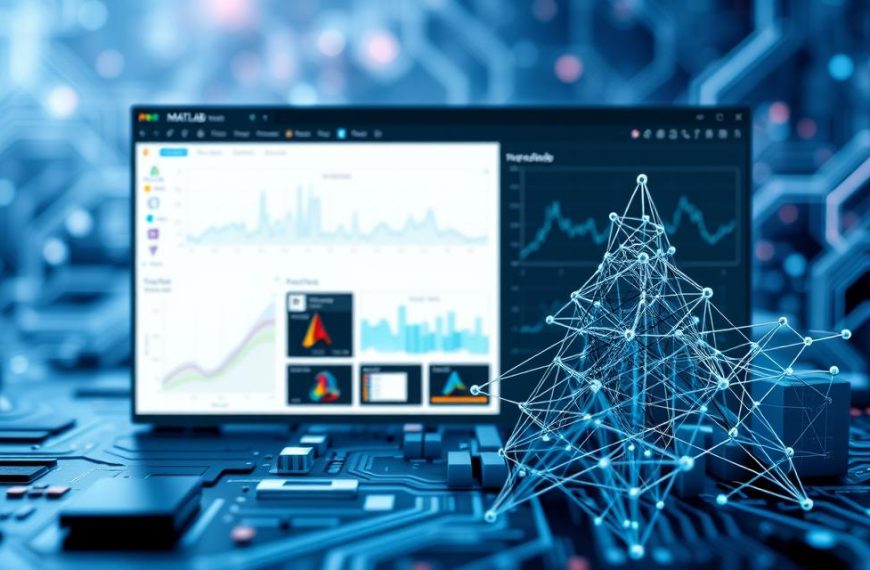Artificial intelligence (AI) serves as the foundation for modern technological advancements. Within this broad field, machine learning acts as a specialized branch. It focuses on using algorithms to analyze data and make predictions. Deep learning, in turn, represents an advanced subset of machine learning, driven by neural networks.
Think of AI as a parent, machine learning as its child, and deep learning as the grandchild. This hierarchy shows how each layer builds upon the previous one. For example, voice assistants like Alexa rely on deep learning to understand and respond to user commands. Similarly, Tesla’s self-driving cars use these technologies to navigate roads safely.
Businesses worldwide are adopting AI at a rapid pace, with 35% already integrating it into their operations. From customer service chatbots to predictive analytics, the applications are vast. Understanding these concepts helps both technical and non-technical readers grasp the future of innovation.
What Is Machine Learning?
At its core, machine learning enables computers to learn from data patterns. Unlike traditional programming, where rules are explicitly defined, machine learning relies on algorithms to identify trends and make predictions. This adaptive approach allows systems to improve over time without constant human intervention.
Definition and Core Concepts
Machine learning refers to a system where computers analyze data to recognize patterns and make decisions. For example, linear regression, a foundational technique, predicts numerical values like income based on historical data. Another critical aspect is feature engineering, which ensures that the models receive clean and relevant inputs for accurate results.
Supervised vs. Unsupervised Learning
In supervised learning, algorithms work with labeled datasets. Spam filters, for instance, use this method to classify emails as spam or not. On the other hand, unsupervised learning identifies patterns without labeled data. A common application is customer segmentation, where businesses group users based on behavior.
Reinforcement learning, another type, involves trial and error with rewards or penalties. Self-driving cars, for example, use this approach to navigate roads safely. According to Syracuse University, these methods are transforming industries by enabling smarter decision-making.
From Netflix recommendations to IBM’s watsonx.ai platform, machine learning powers countless real-world applications. Its reliance on structured data makes it a versatile tool for businesses and researchers alike.
What Is Deep Learning?
Neural networks drive the advanced capabilities of deep learning. These systems mimic the human brain, using layers of artificial neurons to process complex data. With three or more layers, they excel at tasks like image recognition and natural language processing.
Definition and Neural Networks
Deep learning relies on artificial neural networks (ANNs) to analyze data. These networks consist of input, hidden, and output layers. The hidden layers, often two or more, give the system its “deep” designation. For example, Tesla’s self-driving cars use multi-layer networks to recognize STOP signs and other road features.
Unlike traditional methods, deep learning automates feature engineering. This means the system identifies patterns without manual intervention. Such automation makes it ideal for handling unstructured data, which accounts for 80% of enterprise information.
How Deep Learning Differs from Traditional Machine Learning
Deep learning requires significantly more data and computing power than traditional methods. While machine learning works with thousands of data points, deep learning often needs millions. However, techniques like transfer learning reduce training time by leveraging pre-trained models.
- Data Needs: Deep learning thrives on massive datasets, while machine learning works with smaller, structured data.
- Compute Requirements: Cloud computing has made deep learning more accessible, enabling complex tasks like military satellite analysis.
- Feature Engineering: Deep learning automates this process, unlike machine learning, which relies on manual input.
Platforms like Levity are democratizing access to deep learning, allowing businesses to integrate advanced algorithms into their workflows. This shift is transforming industries, from healthcare to autonomous driving.
Is Deep Learning Part of Machine Learning?
Understanding the hierarchy of AI technologies clarifies their roles in innovation. Artificial intelligence (AI) encompasses machine learning (ML), which in turn includes deep learning (DL). This layered structure highlights how each technology builds upon the other.
The Relationship Between Deep Learning and Machine Learning
Deep learning operates as a specialized branch of machine learning. While ML uses algorithms to analyze data, DL relies on artificial neural networks to process complex patterns. For instance, Zendesk’s ticket categorization system uses DL to automate customer support tasks.
Historically, DL emerged from ML research, focusing on multi-layer neural networks. These networks mimic the human brain, enabling advanced tasks like image recognition and natural language processing. According to IBM, the depth of these networks defines the distinction between ML and DL.
Deep Learning as a Subset of Machine Learning
Deep learning’s reliance on models with multiple layers sets it apart. Traditional ML uses shallow architectures, while DL employs deep structures for complex pattern recognition. For example, MIT studies show DL’s dominance in tasks like autonomous driving and medical diagnostics.
Here’s a comparison of ML and DL based on key factors:
| Feature | Machine Learning | Deep Learning |
|---|---|---|
| Layer Depth | Shallow (1-2 layers) | Deep (3+ layers) |
| Data Needs | Structured, smaller datasets | Massive, unstructured datasets |
| Applications | Spam filtering, recommendations | Image recognition, autonomous driving |
Gartner’s AI taxonomy reports emphasize the complementary roles of ML and DL. While ML excels with structured data, DL dominates in handling unstructured information. This synergy drives innovation across industries, from healthcare to transportation.
Key Differences Between Machine Learning and Deep Learning
The evolution of AI technologies has brought machine learning and deep learning into the spotlight, each with distinct characteristics. While both aim to process data and derive insights, their approaches and capabilities vary significantly. Understanding these differences helps businesses choose the right tools for their needs.
Data Requirements and Human Intervention
Machine learning relies on structured data, such as spreadsheets or databases, to train models. This approach often requires extensive human intervention for feature engineering and data preparation. In contrast, deep learning excels with unstructured data, like images or audio, and automates much of the processing.
For example, healthcare systems use machine learning to predict patient readmissions based on structured records. Deep learning, however, can analyze medical images to detect tumors without manual feature extraction. This automation reduces human intervention by up to 80%, according to industry benchmarks.
Complexity and Applications
Deep learning models are inherently more complex due to their multi-layer neural networks. This complexity enables advanced applications like autonomous driving and natural language processing. Machine learning, with its simpler architectures, is better suited for tasks like fraud detection or inventory management.
Here’s a comparison of their key features:
| Feature | Machine Learning | Deep Learning |
|---|---|---|
| Data Type | Structured | Unstructured |
| Development Time | Weeks | Hours |
| Compute Cost | CPU | GPU |
Retailers, for instance, use machine learning to manage inventory but rely on deep learning for visual search applications. These differences highlight the complementary roles of both technologies in driving innovation.
How Machine Learning and Deep Learning Work Together
The synergy between machine learning and deep learning drives modern AI advancements. These technologies complement each other, enabling systems to tackle complex tasks with precision. By integrating their strengths, businesses and researchers achieve groundbreaking results.
Complementary Roles in AI Development
Machine learning often handles preprocessing, preparing structured data for analysis. Deep learning, with its neural networks, takes over for complex pattern recognition. This collaboration ensures efficient and accurate outcomes.
For example, IBM’s hybrid AI architecture combines both technologies. Machine learning filters data, while deep learning analyzes it for insights. This approach powers advanced systems like IBM’s watsonx platform.
Examples of Combined Use Cases
Autonomous vehicles use sensor fusion, where machine learning processes sensor data. Deep learning then interprets this data for navigation. This dual approach ensures safer and smarter driving.
Zendesk’s customer service platform leverages both technologies. Machine learning categorizes tickets, while deep learning analyzes customer sentiment. This integration enhances support efficiency.
Google’s search algorithms also benefit from this synergy. Machine learning clusters search results, and deep learning refines them for relevance. This combination delivers accurate and personalized results.
- Manufacturing QA Pipelines: Machine learning detects defects, and deep learning identifies root causes.
- Medical Diagnosis: Machine learning analyzes patient records, and deep learning interprets medical images.
- AI Art Generation: Machine learning suggests patterns, and deep learning creates detailed artwork.
By combining these technologies, industries achieve innovation and efficiency. The partnership between machine learning and deep learning continues to shape the future of AI.
Applications of Machine Learning and Deep Learning
From enhancing daily convenience to revolutionizing industries, machine learning and deep learning are transforming how we live and work. These technologies power both consumer-facing tools and enterprise solutions, driving efficiency and innovation across sectors. Let’s explore their diverse applications, from everyday use cases to advanced breakthroughs.
Everyday Examples of Machine Learning
Machine learning plays a vital role in simplifying daily tasks. Amazon’s recommendation engine, for instance, uses ML to suggest products based on user behavior. This approach boosts customer satisfaction and drives sales. Similarly, Spotify leverages ML to curate personalized playlists, enhancing user engagement.
In finance, ML powers credit scoring systems, enabling lenders to assess risk accurately. Predictive maintenance in manufacturing reduces downtime by forecasting equipment failures. Dynamic pricing algorithms in retail adjust costs in real time, maximizing profits. These applications highlight ML’s versatility in solving practical problems.
Advanced Applications of Deep Learning
Deep learning excels in handling complex tasks that require advanced pattern recognition. Real-time translation tools, like Google Translate, use DL to process natural language with high accuracy. In healthcare, DL aids in drug discovery by analyzing molecular structures, accelerating research timelines.
Military satellite analysis relies on DL to interpret vast amounts of data, improving decision-making in critical scenarios. Weather prediction models have also seen significant accuracy improvements thanks to DL. These advancements underscore its potential in tackling sophisticated challenges.
| Application | Machine Learning | Deep Learning |
|---|---|---|
| Music Identification | Spotify (ML) | Shazam (DL) |
| Retail | CRM Systems | Virtual Try-Ons |
| Healthcare | Patient Risk Analysis | Radiology Imaging |
| Finance | Fraud Detection | Voice Authentication |
| Manufacturing | Supply Chain Optimization | Defect Detection |
By integrating these technologies, businesses achieve measurable ROI. For example, logistics companies report a 23% cost reduction using ML for route optimization. OpenAI’s GPT-4 showcases DL’s enterprise potential, enabling advanced natural language processing for customer support and content creation.
Why Understanding the Difference Matters
The distinction between machine learning and deep learning shapes the future of AI. Choosing the right approach ensures efficient resource allocation and maximizes project success. Missteps in this decision can lead to wasted time and resources, with 58% of failed AI projects attributed to the wrong approach.
Today, businesses face a critical choice: invest in machine learning for structured data or adopt deep learning for complex, unstructured tasks. This decision impacts not only immediate outcomes but also long-term innovation. For example, Zendesk achieved 70% faster resolution times by integrating AI into its customer service platform.
Choosing the Right Approach for Your Needs
To select the best method, evaluate your project’s data, scope, and resources. Machine learning works well with structured datasets and requires less computational power. It’s ideal for tasks like fraud detection or inventory management.
On the other hand, deep learning excels with unstructured data, such as images or audio. It automates feature extraction, reducing human intervention. However, it demands significant computational resources and expertise. For instance, healthcare systems use deep learning to analyze medical images, achieving higher accuracy.
Impact on AI Development and Innovation
The synergy between these technologies drives AI advancements. Machine learning preprocesses data, while deep learning handles complex pattern recognition. This collaboration powers innovations like autonomous vehicles and real-time translation tools.
Ethical considerations also play a role. IBM’s trustworthy AI principles emphasize fairness and transparency. Compliance with regulations like the EU AI Act ensures responsible AI development. Additionally, deep learning’s bias detection capabilities help mitigate ethical risks.
| Feature | Machine Learning | Deep Learning |
|---|---|---|
| Data Type | Structured | Unstructured |
| Development Time | Weeks | Hours |
| Compute Cost | CPU | GPU |
| Applications | Fraud Detection | Image Recognition |
Looking ahead, the rise of AutoML democratizes access to AI, enabling smaller teams to leverage these technologies. Quantum computing’s future impact could further revolutionize the field. By understanding these differences, businesses can make informed decisions and drive meaningful innovation.
Conclusion
The future of innovation hinges on understanding the roles of machine learning and deep learning. These technologies, while distinct, complement each other in driving artificial intelligence advancements. Key differentiators include data requirements, complexity, and autonomy. For example, machine learning excels with structured data, while deep learning thrives on unstructured inputs.
Businesses like Zendesk have achieved significant results by integrating AI into their workflows. Generative AI is accelerating, with the deep learning market predicted to grow at a 38% CAGR through 2030. To leverage these technologies, consider learning paths like Coursera or hands-on labs. Tools like AWS SageMaker Canvas and no-code solutions such as Levity simplify adoption.
However, avoid viewing AI as a “silver bullet.” Pilot projects with clear KPIs ensure measurable success. Regulatory scrutiny is increasing, emphasizing the need for ethical AI practices. By understanding these technologies, businesses can strategically adopt AI and drive meaningful innovation.












